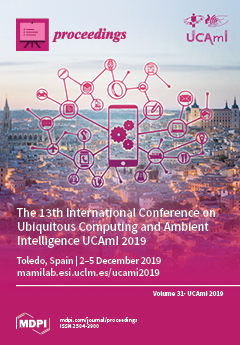Need Help?
Proceedings, 2019, UCAmI 2019
13th International Conference on Ubiquitous Computing and Ambient Intelligence UCAmI 2019
Toledo, Spain | 2–5 December 2019
Volume Editors:
José Bravo, University of Castilla–La Mancha, Spain
Iván González, University of Castilla–La Mancha, Spain
- Issues are regarded as officially published after their release is announced to the table of contents alert mailing list.
- You may sign up for e-mail alerts to receive table of contents of newly released issues.
- PDF is the official format for papers published in both, html and pdf forms. To view the papers in pdf format, click on the "PDF Full-text" link, and use the free Adobe Reader to open them.
Cover Story (view full-size image):
Embedding communication transceivers and sensitive electronic into everyday objects to help with daily functions is the main challenge of the Ubiquitous Computing (UC) paradigm, envisioned by Weiser
[...] Read more.
Embedding communication transceivers and sensitive electronic into everyday objects to help with daily functions is the main challenge of the Ubiquitous Computing (UC) paradigm, envisioned by Weiser in 1991. Recognizing that this extension of computational capabilities to appear anytime and anywhere would require gathering more complex information about the environment (context awareness) and the understandings of social, cultural, and psychological phenomena, the UC paradigm has evolved to a more general one called Ambient Intelligence (AmI). Both are the main focus of the International Conference on Ubiquitous Computing and Ambient Intelligence (UCAmI). This event will cover a plethora of related topics: Ambient Intelligence for Health; Smart Environments; IoT and sensors; human–computer interaction; and Ambient Intelligence for education and to promote active and assisted living.
Previous Issue
Next Issue
Issue View Metrics
Multiple requests from the same IP address are counted as one view.



